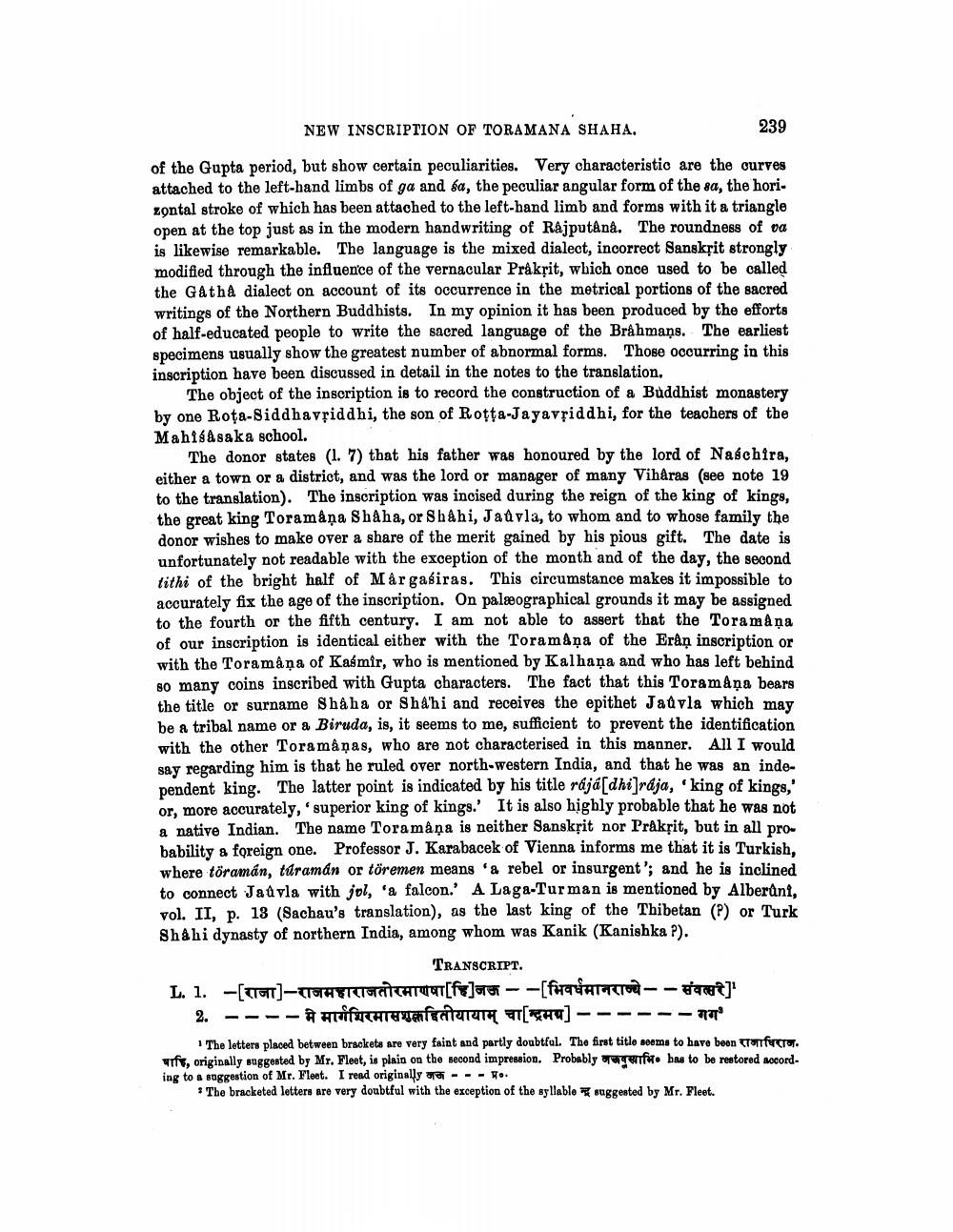________________
NEW INSCRIPTION OF TORAMANA SHAHA.
239
of the Gupta period, but show certain peculiarities. Very characteristic are the curves attached to the left-hand limbs of ga and sa, the peculiar angular form of the sa, the horizontal stroke of which has been attached to the left-hand limb and forms with it a triangle open at the top just as in the modern handwriting of Rajputânâ. The roundness of va is likewise remarkable. The language is the mixed dialect, incorrect Sanskrit strongly modified through the influence of the vernacular Prâkrit, which once used to be called the Gatha dialect on account of its occurrence in the metrical portions of the sacred writings of the Northern Buddhists. In my opinion it has been produced by the efforts of half-educated people to write the sacred language of the Brahmans. The earliest specimens usually show the greatest number of abnormal forms. Those occurring in this inscription have been discussed in detail in the notes to the translation.
The object of the inscription is to record the construction of a Buddhist monastery by one Rota-Siddhavriddhi, the son of Rotta-Jayavriddhi, for the teachers of the Mahisasaka school.
The donor states (1. 7) that his father was honoured by the lord of Naschira, either a town or a district, and was the lord or manager of many Vihâras (see note 19 to the translation). The inscription was incised during the reign of the king of kings, the great king Toramana Shaha, or Shahi, Jadvla, to whom and to whose family the donor wishes to make over a share of the merit gained by his pious gift. The date is unfortunately not readable with the exception of the month and of the day, the second tithi of the bright half of Mår gasiras. This circumstance makes it impossible to accurately fix the age of the inscription. On palæographical grounds it may be assigned to the fourth or the fifth century. I am not able to assert that the Toramâna of our inscription is identical either with the Toramana of the Eran inscription or with the Toramâna of Kasmir, who is mentioned by Kalhana and who has left behind so many coins inscribed with Gupta characters. The fact that this Toramana bears the title or surname Shâha or Shahi and receives the epithet Jaûvla which may be a tribal name or a Biruda, is, it seems to me, sufficient to prevent the identification with the other Toramânas, who are not characterised in this manner. All I would say regarding him is that he ruled over north-western India, and that he was an independent king. The latter point is indicated by his title rájá[dhi]rája, 'king of kings," or, more accurately, 'superior king of kings.' It is also highly probable that he was not a native Indian. The name Toramâna is neither Sanskrit nor Prâkṛit, but in all probability a foreign one. Professor J. Karabacek of Vienna informs me that it is Turkish, where töramán, túramán or töremen means 'a rebel or insurgent'; and he is inclined to connect Javla with jol, 'a falcon.' A Laga-Turman is mentioned by Alberânt, vol. II, p. 13 (Sachau's translation), as the last king of the Thibetan (?) or Turk Shahi dynasty of northern India, among whom was Kanik (Kanishka ?).
TRANSCRIPT.
I. 1. - [ राजा ] - राजमहाराजतीरमायणा][[च] जज [भिवर्धमानराज्ये --संवार] - मे मार्गशिरमासशुक्लद्दितीयायाम् चा[न्द्रमग्र] -
2.--
- -
गग
1 The letters placed between brackets are very faint and partly doubtful. The first title seems to have been refererer. fe, originally suggested by Mr. Fleet, is plain on the second impression. Probably fe has to be restored accord
ing to a suggestion of Mr. Fleet. I read originally --.
* The bracketed letters are very doubtful with the exception of the syllable suggested by Mr. Fleet.




